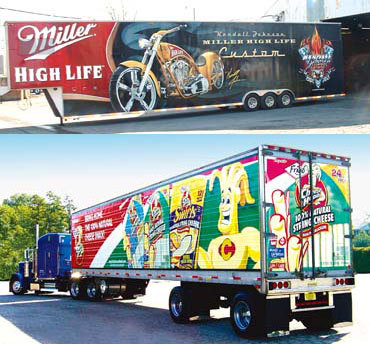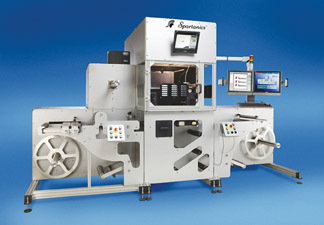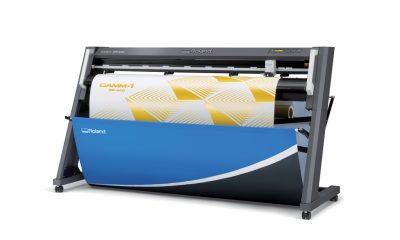Graphics Printing
Published
17 years agoon

Without a doubt, vehicle wraps continue to grow in popularity and effectiveness and have become an important component in the mix of outdoor advertising media. The first wrap was created a bit more than a decade ago, turning an average city bus into a moving billboard. Since then, every type of vehicle has become fair game for wrapping with printed pressure-sensitive vinyl graphics. Not too long ago, we would say, if it can move, it can be wrapped.
Without a doubt, vehicle wraps continue to grow in popularity and effectiveness and have become an important component in the mix of outdoor advertising media. The first wrap was created a bit more than a decade ago, turning an average city bus into a moving billboard. Since then, every type of vehicle has become fair game for wrapping with printed pressure-sensitive vinyl graphics. Not too long ago, we would say, if it can move, it can be wrapped. Now, if an item is an important personal expression of who you are or what you want to be and it has a smooth surface, it can and should be wrapped, whether it’s an MP3 player, cell phone, sports gear, or other personal item.
This won’t be the traditional "How to Create the Perfect Vehicle Wrap" article. This discussion is for those of you who ever wondered why or how vehicle graphics became so popular and asked what’s next. We will look at the trends driving the explosive growth in vehicle wraps, the technology factors that enable the explosion, and what may be ahead.
Consumer demand
Fleet advertising (Figure 1) has long been established as an extremely powerful and cost-effective form of outdoor advertising—generating interest, curiosity, and results. National corporations, regional companies, and even single-vehicle operations have realized the benefits of utilizing pressure-sensitive vinyl graphics on their fleets. Printed vinyl provides the look of paint at a fraction of the cost, the ability to change the message and brand, and the high impact of large, full-color images.
The evolution of fleet advertising is leading to dynamic change and growth in the vehicle-wrap industry as wraps are becoming more accessible to individual consumers. And consumers are bringing their preferences and trends to the table when they make their wrap decisions. The key trends that are fueling the demand from consumers for wrapped vehicles follow:
I want it now. With the instantaneous, information-at-a-moment, knock-off pace at which our society moves, we all have the "make it faster, more affordable" mindset. Vinyl-wrapped vehicles deliver the look of high-end paint quickly and at an affordable price. The Internet gives us access to instant information and gratification, and vinyl vehicle wraps deliver exactly that.
Now that I have it, I want to change it. For some new vehicle-wrap consumers, custom car graphics are fashionable now, but what’s hot changes quickly (Figure 2). Sound familiar? In the advertising world, messaging is more complex and a promotion’s life span is becoming shorter with more frequent change. Advances in the adhesive systems of pressure-sensitive vinyl allow for more changeable graphics.
Make it easy for me. The element of DIY grows as vehicle graphics move more into the consumer realm. This doesn’t mean general consumers will be printing and installing their own vehicle graphics in the immediate future, but a new audience of graphics novices wanting to break into the auto-wrap field is emerging. New design software, easier-to-use printers, easy-to-install vinyl materials, and the availability of training programs are enabling a broader audience to apply graphics.
Make mine unique. Consumers have more choices than ever across a range of products. Choice is not necessarily a good thing when everything looks and performs the same. In this sea of sameness, more and more consumers are looking for a way to take an off-the-shelf item and, through the addition of a distinct color and/or design treatment, customize it to create an expression of their own personal identity. This new demand for customization and personalization is a key driver that is fueling consumer interest in wraps, and the trend is growing well beyond advertising and custom show cars.
I’ll have what they’re having. Luxury items in fashion, automotives, and home goods were once accessible to only the wealthiest and most powerful consumers. Through the adoption and development of faux finishes, synthetic materials, special-effect materials, mass production, and computer-aided design, these luxury goods have been copied and pushed out into mass markets. Consumers not only accept well-executed imitations, but they also expect them and seek them out.
Pressure-sensitive vehicle wraps are a great example of this. Sign vinyl has been used for many years to replace hand-painted fixed and vehicle signage. Vinyl has become the medium of choice during the past decade to duplicate the look of custom automotive paint jobs at a fraction of the cost. Now, the design sophistication possible with digitally imaged automotive graphics is surpassing the traditional capabilities of painted vehicle graphics. A key benefit of electronically designed vehicle graphics is that you can look at and change the design before you image and install it. Paint is a commitment and expensive, while vinyl is changeable and affordable.
The new vehicle graphic customer
In many ways, the new vehicle-wrap consumer is also the same business person who’s making the decision to mark a business fleet with printed vinyl graphics. The line between personal and professional is definitely blurring, and these hybrid consumers are bringing the preferences and needs created by these trends with them to the vehicle-wrap arena.
How do these trends translate into the vehicle-wrap market? All of these trends are forcing suppliers and participants in the vehicle-wrap industry to create new, innovative products and services that are faster, easier, more flexible, and increasingly cost-effective. This encompasses everyone in the supply chain—material and ink suppliers, designers, printers and converters, distributors, and installers.
The notion that the growth of printed pressure-sensitive vehicle graphics will eliminate paint, and that new, real-time design software will surmount the professional designer is a misconception. The good news is that the vehicle-wrap pie is getting bigger, with more corporate and individual consumers participating and new levels of technologies, materials, and services being maintained and added to the industry model. Even better, while traditional fleet advertising is growing at a healthy 4-5% per year, the vehicle-wrap industry is experiencing impressive growth at more than 15% annually.
As this market grows, so does the opportunity to innovate and introduce new products for vehicle graphics, giving the industry’s sales outlets the opportunity to bundle related products. A good example is digitally printable reflective and special-effect pressure-sensitive films that provide designers and installers a way to combine graphic design and functionality. Special-effect films include printable metallics, ultra metallics, and pearlescent looks that can accent a digitally printed wrap as an overlaid decal and give special emphasis to any portion of the wrap’s graphics. Reflective films that are printed and computer-cut into overlay decals provide safety emphasis and design impact.
Technology’s influence
Trends fuel the movement, but other reactive forces are enabling growth in vehicle wraps. Without question, the Internet, together with the information and entertainment industries, is redefining what consumers want and how it’s delivered and experienced. But a key advancement is computer technology that enables designers to create graphics that move beyond the look of a sticker. Images can be changed over and over to satisfy the creative whims of the client or to meet the specialized needs of a nationwide vehicle-wrap program for a huge advertiser.
The critical benefit inherent in computer design is the ability to duplicate a graphic and adapt it across a variety of vehicle types and different products and substrates (Figure 3). While individual consumers are responding to the personalization trend, repeatability of computer-designed visuals attracts companies with large volumes of wrap projects in which a variety of vehicles are imaged with a unified look and feel. It is the ability to customize each vehicle for regional messaging requirements that makes vehicle wraps flexible and adaptable.
Those who design vehicle graphics draw upon a different set of trends and influences. Many of the mega trends already covered may apply, but this unique group tends to call up strong visual and lifestyle cues for inspiration. The incredible popularity of the NASCAR experience is having a huge impact on design because it’s the most visible medium for vehicle wraps. The high-performance looks inspired by NASCAR influence graphic treatments and the use of color found on today’s wrapped vehicles.
The look of carbon fiber is one of the most popular themes borrowed from high-tech applications. This is an application best conveyed by printed pressure-sensitive vinyl. It creates a high-end impression at a fraction of the cost of the original inspiration. In this case, imitation truly is the sincerest form of flattery. Carbon-fiber patterning serves as background texture and is incorporated into sophisticated vehicle-graphic designs, whether they are full or partial wraps.
Designers are also looking at the importance of techno/industrial visual themes (Figure 4), such as steel and other metal looks. These themes strongly influence vehicle-graphic designs to have clean lines and less complex graphic execution. This type of clean, simple design lends itself to creating a backdrop that simplifies the addition of business logos, delivering a vehicle look that is personal and effective at promoting a brand.
Another emerging design influence is motocross sports. Extreme designs—clean, edgy and very simple—used on motorcycles, helmets, and clothing are being transformed into vehicle decals and wrap graphics. Other lifestyles, such as off-road, urban, and tuner cars are driving new design trends as well. These designs are special-effect intensive and deliver high visual impact on metallic and reflective films for customized vehicles. The new designs being created for these specialized consumer groups are taking the sophistication of vehicle graphics to a new level with the introduction of "speed-style" and "effect-type" art. This movement delivers new, complex dimensional colors and printed special effects not seen before in vehicle graphics.
Designers are moving beyond the parameters of simply mimicking the look of high-end paint and are creating a distinguished look only possible through printed vehicle graphics. This evolution of design is fueled by the audience for vehicle graphics. Consumers now have a trained eye and know that pressure-sensitive graphics don’t have to look like just a sticker. Achieving the look of high-end paint on pressure-sensitive vinyl will only be possible at the hands of a good designer. A critical step to ensure a realistic paint effect is the application of a high-gloss overlaminate that adds protection and durability, and makes the printed images pop.
In addition to advances in the Internet, design software, and design expertise, technology improvements in ink systems, protective film overlaminates, and printing equipment have enabled the vehicle-wrap industry to graduate from old-school to an important growth area in the overall printing and imaging marketplace. A critical component of this mix is the improvement being made to cast vinyl films and adhesive systems. Material selection is critical. How the material accepts and retains the ink, how it lays down and conforms in application, and how it performs over time are all important factors to consider. You also should be able to have confidence in their performance. New and improved of easy application films are coming to market. They allow installers to choose the type of positionability, and even slideability, that is right for the job at hand. Designers can do their job and create awesome graphics, but the finished vehicle wrap is only as good as the application.
That’s a wrap
It’s safe to say that vehicle wraps are here to stay, or at least until another wave of mega trends washes the application in another direction. In the meantime, we can all enjoy the excitement of seeing a growing part of the printing and imaging industry move outside of the commercial and professional market and into the consumer arena. Consumers will guide us to what is next for the future of vehicle graphics. Huge opportunities are available for all stakeholders in graphic design, printing, materials supply, and sales to participate in the growth and enjoy the creativity.
About the author
Joel Ross is Global Market Segment manager, Transportation, with Avery Dennison Graphics and Reflective Products Division in Cleveland, Ohio. He is responsible for driving Avery Graphics’ transportation market strategies, and the growth of applications for Avery’s fleet and vehicle-wrap imaging products. He has been a member of the Color Marketing Group since 2003 and the Recreational Vehicle Industry Association since 2002.

Subscribe

Magazine
Get the most important news
and business ideas from Screenprinting Magazine.
Most Popular
-

 Art, Ad, or Alchemy1 month ago
Art, Ad, or Alchemy1 month agoF&I Printing Is Everywhere!
-

 Case Studies1 month ago
Case Studies1 month agoHigh-Density Inks Help Specialty Printing Take Center Stage
-

 Andy MacDougall1 month ago
Andy MacDougall1 month agoFunctional and Industrial Printing is EVERYWHERE!
-

 Columns2 weeks ago
Columns2 weeks ago8 Marketing Mistakes Not to Make When Promoting Your Screen Printing Services Online
-

 Editor's Note2 weeks ago
Editor's Note2 weeks agoLivin’ the High Life
-

 Thomas Trimingham2 months ago
Thomas Trimingham2 months ago“Magic” Marketing for Screen Printing Shops
-

 Marshall Atkinson2 weeks ago
Marshall Atkinson2 weeks agoHow to Create a Winning Culture in Your Screen-Printing Business
-

 News & Trends1 month ago
News & Trends1 month agoWhat Are ZALPHAS and How Can You Serve Them in Your Print Business?






